#1960 Printed in France
Note
Do have any opinions/resources about the situation in Niger? You’re the most knowledgeable of the people I know about French colonialism and that seems to be at the centre of the recent protests and coup.
First of all I am in no way or shape a specialist in the subject of French colonialism. I learned everything because it’s part of my family history (proud grand daughter and great grand daughter of freedom fighters) and the decolonization of all of Africa is part of the history of Algeria and therefore part of my history. Because you cannot learn about decolonization without learning about colonization I had to learn about France’s colonial history in the rest of Africa and eventually in the rest of world.
One thing to keep in mind when addressing military coups in Africa is that the military was created in a very different context than it was in the West. In Africa a lot of armies were created by freedom fighters who go fought against colonialism. It doesn’t mean that their modern version is not corrupted and that it is never used as a way to oppress the people. But unlike the west where the army was often created to protect the powerful, in Africa it often originated in groups of men fighting to protect the people from the powerful colonial power.
Anyway to your question! To use the words of Gabon’s first president after the independence in 1960 when he visited France after his election in 1961 “Gabon is independent, but between Gabon and France nothing has changed; everything goes on as before.” And this applies to too many African countries.
France refuses to accept the independence of African countries. They have a paternalist colonial behavior with us. Algeria is one of the rare former French colonies who manages to say fuck you to France and even Algeria is not completely free to say fuck you because of the consequences it could have on us Algerians who live in France. Because of France’s refusal to accept the independence and the desire to keep a form of control over the continent France has been involved in multiple assassination and coup d’Etat in the continent. They were also involved in multiple civil wars. They control the currency of some African countries. How can you be independent when your currency is owned and printed by the former colonizer?
Terrorism gives an excuse to France to send its army in the continent especially in the Sahel region and that same army pillages the region instead of actually helping against terrorism. Now when those countries decide that France’s presence is doing more harm than good and kick out France they are vilified. They are told they are controlled by someone else (depending on the situation their either accuse Algeria or Russia or both). It happened with Mali and Mauritania. And this is what’s happening with Niger.
Africa is a young continent in term of population. The youth kicked out colonizers in the 60’s and 70’s. Now the young generation wants to get rid of Neo-colonialism. African governments who are greedy and let the colonizers take whatever they want need to go. If it has to happen with a Coup d’Etat then so be it. That’s my personal opinion in general not specifically for Niger.
For Niger specifically I don’t know enough about Abdourahamane Tiani and don’t have enough perspective to decide if I support him personably but I have enough knowledge and perspective to support the demise of Mohamed Bazoum government and the decision to cut tie with France. France is still pillaging Africa and Bazoum was allowing it in Niger. The simple fact that the ECOWAS is standing in favor of Bazoum and willing to actually start a war should be enough to tell you that what is happening in Niger is bad for France’s interests. And if it’s bad for France’s interest if the new leader is not corrupted then it will be good for the country. The ECOWAS pretends to act in the interest of the continent but it only benefits France. The countries that were suspended are the same countries that are getting rid of French influence and Neo-colonialism. Corrupted African leaders who serve as France’s lapdogs refuse to have fair elections so the only solution to kick them out and gain real freedom is a coup or a revolution. It’s not an accident if all the latest coup d’etat in Africa happened in former French colonies. It’s not an accident if a big portion of the population support those coups. People are fed up by the control France still has.
(I actually read something very interesting about what’s happening in Niger yesterday but can’t find it anymore I will share a link later if I find it again)
Also I just want to add something off topic about terrorism in Africa and South West Asia. I find it extremely fascinating how countries where the US, France or the West in general came to “help” never managed to find a durable solution against terrorism. Meanwhile during the Algerian Black decade/civil war in the 90’s, Algeria refused to let France and the US send soldiers to “help” and we did eventually find a durable solution on our own.
111 notes
·
View notes
Photo

“MODEL WITH SHOES ON HER SHOULDERS”
GUY BOURDIN // FRANCE, APR. 1960
[gelatin silver print | 36.7 × 29.9 cm.]
#guy bourdin#fashion#surreal#60s#fashion photography#france#monochrome#black and white#analog#film photography#french#photography#u
99 notes
·
View notes
Photo
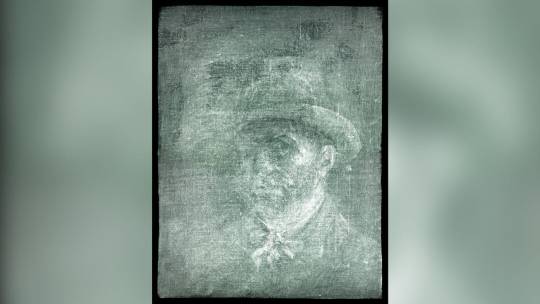

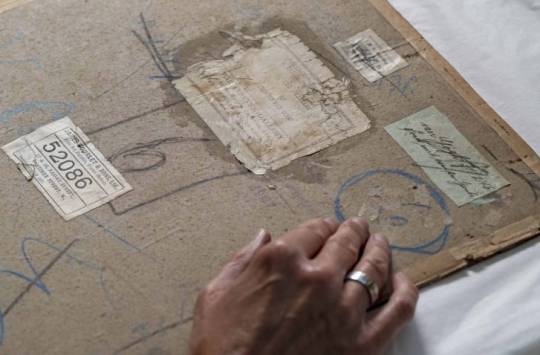

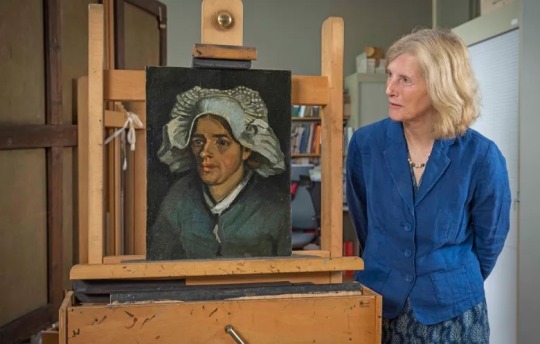
Hidden Van Gogh Self-Portrait Found Behind Another Painting
A hidden self-portrait by Vincent van Gogh has been discovered behind one of his paintings, covered by layers of glue and cardboard for more than a century.
The image was found when art conservators took an X-ray of Van Gogh's 1885 "Head of a Peasant Woman" painting ahead of a forthcoming exhibition. They discovered the concealed image at the back of its canvas hidden by a sheet of cardboard, according to a press release from the National Galleries of Scotland (NGS).
Experts say the revealed artwork is believed to have been unknown until now.
"Moments like this are incredibly rare," said Frances Fowle, senior curator of French art at the NGS, in the press release Thursday. "We have discovered an unknown work by Vincent van Gogh, one of the most important and popular artists in the world."
The Dutch master often re-used canvases to save money, turning them around to work on the reverse side, the NGS said.
The underlying self-portrait is thought to have likely been made during a key moment in Van Gogh's career, when he was exposed to the work of the French impressionists after moving to Paris.
The "utterly compelling" X-ray image shows "a bearded sitter in a brimmed hat with a neckerchief loosely tied at the throat. He fixes the viewer with an intense stare, the right side of his face in shadow and his left ear clearly visible," according to the release.
While the condition of the actual self-portrait is unknown, if it can be uncovered, it is expected to help shed a new light on the renowned artist.
The process of removing the glue and cardboard will require delicate conservation work. Research is ongoing as to how this can be done without harming "Head of a Peasant Woman."
The painting, which shows a local woman from the town of Nuenen in the south of the Netherlands, where the artist lived from December 1883 to November 1885, came into the possession of the NGS in 1960 as a gift from an Edinburgh lawye.
It was probably around 1905, when "Head of a Peasant Woman" was lent to an exhibition at the Stedelijk Museum, in Amsterdam, that the decision was made to stick the canvas down on cardboard prior to framing, according to the press release. The NGS added that, at the time, "Head of a Peasant Woman" was likely considered more "finished" than the Van Gogh self-portrait.
The painting changed hands several times until it went to Scotland in 1951.
The X-ray image can be seen publicly for the first time through a specially crafted lightbox when it takes center stage at the "A Taste for Impressionism" exhibition between July 30 and November 13 at the Royal Scottish Academy, in Edinburgh.
It is not the first time that paintings by famous artists have been discovered beneath other works.
Earlier this year, it was revealed that an intriguing image of a Madonna and Child had been discovered beneath the paint layers of a $40-million Botticelli painting.
And artificial intelligence, advanced imaging technology and 3D printing was used to uncover a nude portrait of a crouching woman hidden beneath the surface of a Pablo Picasso painting last year.
By Amarachi Orie.
#Hidden Van Gogh Self-Portrait Found Behind Another Painting#Van Gogh's 1885 Head of a Peasant Woman#painting#painter#dutch post-impressionist painter#art#artist#art work#art world#art news#history#history news#vincent van gogh
47 notes
·
View notes
Text
retournement de veste !
All the kpop idols being invited to fashion events and becoming houses ambassadors made me think about how fashion luxury houses are so fast to turn around and try to seduce a public they used to turn their backs to. In fact, these companies have always wanted to dissociate themselves with certain groups and figures. The Kardashians are a great example of this phenomenon, luxury houses didn’t really want anything to do with them until Balmain’s creative director Olivier Rousteing took an interest in the family.
In France, owning luxury items is popular in urban areas leading to a love and hate relationship between fashion houses and these populations that don’t fit the image of said houses. The derogatory, racist and classist term “Lacoste TN” designate young black and north African men living in urban areas dressing in Lacoste tracksuits with AirMax TN sneakers. The term is widely known and shows the popularity of this style mixing streetwear and luxury. Unfortunately for these houses, this is not the lifestyle and outdoor activities they are trying to promote :( The luxury tennis outfit oriented brand Lacoste especially, whose popularity in the suburbs is incredible, has been vocal about not wanting to associate with this group. Eventually, with them playing quite a large part in Lacoste’s sales in France, the house ended collaborating with french rapper Moha La Squale.
France is not the first country encountering this behavior. Actually, the popularization of streetwear, monogram, sneakers and chunky jewelry in luxury is due to the African American community in neighborhoods of New York and Hip Hop music. Dapper Dan was an amazing designer from Harlem, is influence on black music and the style associated with it is huge. His work at first consisted of creating knock-offs of luxury items and playing around with logos. That is how the monogram print was popularized. Luxury houses which excluded black people, did not want to be associated with them or their music, called their style tacky, ghetto or ratchet started reappropriating these creations and selling them to white rich people in the suburbs.
When European luxury houses first made their first steps into Asia, whiteness and the Parisian style was the goal. Boarding school uniform inspired preppy was in vogue in Japan starting from the 1960′s. I have always found it odd how 30 years later, with the rise of Harajuku fashion and the popularity of streetstyle photography magazine FRUiTS, these brands never tried to collaborate or work with young Japanese artists. It was maybe too tacky for them, too out of pocket or too “street” since it seems like it is a global problem. So it is funny now to see how Heavn by Marc Jacobs collaborated with FRUiTS Magazine’s photographer Shoichi Aoki and tried to mimic an aesthetic by watering down alternative asian fashion culture and manufacturing it to sell it to the mass while the whole purpose of the movement was to protest against social norms by being unique and creating unique in the world pieces mixing traditional and modern clothing. I am not trying to say i hate the brand, I actually liked it at first, I am juste a girl in my twenties who likes asian fashion so of course I liked it. But when thinking about it, nothing new has been created, everything they sell is already available on the market. It just caters down to mass consumerism and the “weird girl aesthetic” that for some reason makes me think of the manic pixie dream girl except it is fashion.
Now with the influence of Korean culture you know they had to ! Houses will go out of their way to have at least one Korean celebrity sit at their show, idols being the golden ticket. Even if this is not new and even if I am glad artists get this opportunity, I find it sad and sometimes reducing to invite pretty faces instead of actually working with them on interesting projects, especially since South Korea is a buzzing spot for emerging designers and small artists. It is like non white people have two options: be excluded or be a totem.
(if you want to know more about Heavn i suggest you watch this video ! it is really interesting and i agree with everything being said)
7 notes
·
View notes
Text
A Degenerate Assemblage
Book Madness: A Story of Book Collectors in America
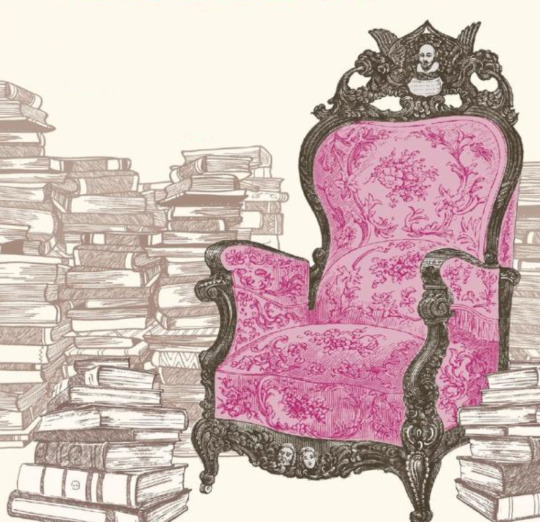
by Anthony Grafton
New York was a great book town in the 1960s. You could buy new books in English at the elegant Scribner shop on Fifth Avenue, new books in French at the Librairie de France or Rizzoli, and old books in German at Mary S. Rosenberg’s austere, packed shop on Broadway, where neither I nor another obsessive friend could afford $100 for a first edition of Winckelmann’s history of ancient art. You could pick up New Directions poets in the Village, Hebrew seforim in Brooklyn and German magazines in Yorkville. If you wanted rarities, you could browse the dusty, chaotic secondhand bookshops on Fourth Avenue and Broadway. At the dustiest and wildest of them all, Dauber and Pine on Fifth, one of the owners sold me a 17th-century Latin book on Druids that I couldn’t afford at half-price (‘rainy day special’, he explained). Higher-end bookshops offered incunabula and Aldines, first editions of Gibbon and Austen to discriminating buyers who had real money.
If you didn’t, you could explore the riches available in public collections. New York Public Library branches were stuffed with new fiction and old treasures, which anyone could borrow or read. Anyone over eighteen could explore the marble labyrinths of what is now called the Stephen A. Schwarzman Building: a palace of the people on 42nd Street, traditionally known as the Main or Central Branch, with its encyclopedic holdings. In the reading room, battered but still grand, readers waited for their number to appear on the indicator – the library ran on steampunk systems, which supposedly included ‘pages’ on roller skates traversing the stacks at high speed. There I inched, pen in hand, through the huge folio volumes, bound in buckram, of the 18th-century edition of Erasmus’s complete works. An untidy man who studied the racing form with equal care sat at the same varnished table, warmed by the same fading beams of the pale city sun. When my father felt depressed, he would visit the print room and look at a Dürer. The Morgan Library, the New York Academy of Medicine and Columbia’s rare book collections served those with more specialised needs.
New York couldn’t compete with London or Paris: it had no bouquinistes, no Farringdon Road, no British Library or Bibliothèque nationale de France. It lacked the quaint bookshops of Boston, where the staff seemed to know not only the books they sold but their 18th and 19th-century authors, not to mention Harvard’s Widener Library. But it was still a city of books, collectors and readers. Every good secondhand bookshop offered guidance for neophytes: A. Edward Newton’s chatty books about his bookish adventures; Holbrook Jackson’s erudite Anatomy of Bibliomania, a comprehensive treatment of obsessive book-buying in the manner of Robert Burton; and sometimes even a copy of Carter and Pollard’s Inquiry into the Nature of Certain 19th-Century Pamphlets, the exposé that dished Thomas J. Wise, forger of rare editions. It all seemed to contradict the rants of intellectuals about the barrenness of American culture. Many of the angelheaded hipsters whom I met busied themselves in learning Old Church Slavonic or translating Rimbaud. Meanwhile, pioneering scholars like Barbara Tuchman, Frank Manuel and George Whalley mined gold year after year from the lodes of ore in the libraries.
READ MORE
6 notes
·
View notes
Text
Art and Artists, September 1966

Cover by René Magritte, L’Art de Conversation

Dining with Jim
Robert Fraser talks to Jim Dine about London and New York
Pp 48-53
The entire interview is under the cut, along with scanned pages of Dine's art from that issue.
Here's a quick cheat sheet for potentially obscure references:
Louis Seize: the architecture or furniture of the reign of Louis XVI of France
Paolozzi: Eduardo Paolozzi, Scottish artist known for his sculpture and graphic works. He had shows at the Robert Fraser Gallery.
Richard Hamilton: British painter and collage artist. He produced a series of prints, Swingeing London, based on Robert Fraser's arrest, along with Mick Jagger, for possession of drugs.
Biba: London fashion store of the 1960s and 1970s.
Nancy: Nancy Dine, American filmmaker, married to Jim Dine.
Dada: Art movement of the early 20th century, which rejected rejected the logic, reason, and aestheticism of modern capitalist society, instead expressing nonsense, irrationality, and anti-bourgeois protest. Surrealism was a branch of Dadaism.
Furlined teacup: Luncheon in Fur, surrealist art by Meret Oppenheim. In 1936, Oppenheim wrapped a teacup, saucer and spoon in fur.
Oldenburg: Claes Oldenburg, Swedish-American sculptor. He had shows at the Robert Fraser Gallery.
Robert Morris: American artist who was one of the central figures of the Minimalism movement.
Alloway: Lawrence Alloway, American art critic and curator.
George Cohen: English footballer who was awarded an MBE in 2000 for his many victories on the field.

Robert Fraser: This room is where you have been doing all the work that you have done so far in England?
Jim Dine: Yes. Just in this room, which I felt was a good place to contain it because the room is absolutely not about making anything. It’s what you’d call extra, like the game room or the hunt room with those horns and the Oxford oar and all that sort of Louis Seize business over there and the scrap books and the globe and the flowered wallpaper and the book shelves and the shot-gun shelves and the sherry bottles and all that sort of, you know, contract bridge manuals and the like. I mean it’s so completely not mine that it might as well be all white. It seems to me you could make anything in here.
RF: Yes. But it seems to be so far removed from your actual world.
JD: Absolutely.
RF: And also has a certain aimless incongruity which obviously has had an effect on you.
JD: Right.
RF: Or on what you’re doing.
JD: Absolutely. Absolutely. It’s really like a sounding board for all kinds of freedom. You know, so that one doesn’t feel type cast into making one thing here. I mean I feel like I could make a thousand different kinds of things in here.
RF: Is that more or less the sort of reaction that you’ve had in general to the landscape and general tone of life over here?
JD: Yes, and it’s because I’m not at home. You know, it’s the ‘sailor on leave’ theory. It’s like not being here, not having to answer to anything at home in New York. Being in England, then you do something different. I don’t think I could live here. At home, expatriation is not interesting to me, but as a visitor it’s interesting to see what one does purely by associating things.
RF: But are there any special freedoms or reactions or inhibitions which you’ve felt responses to, which you think are particular to London itself?
JD: Oh yes. I feel terribly much like a refined person in New York, but here I feel like a woodsman or something. I feel like a bull in a china shop, bustling through London. I never feel I’m as civilized as the natives or the artists who live here, because they seem so much part of one scene. No matter what kind of image they make – except for Paolozzi. He’s the only one who’s international. One gets the feeling he need not be anywhere; this is strictly owing to the kind of hermetic atmosphere here.
RF: This is not because you feel culturally unsophisticated?
JD: Oh, no, no, no. It’s because it’s like walking into a green-house where there are these rare plants.
RF: Would you say that this very hermetic atmosphere has brought a sudden reaction to art in this country?
JD: I think it’s obvious. I mean, One doesn’t have much trouble knowing what an English painting looks like. And there’s this sort of sense of personal freedom over here that one never feels in America. In America, one always feels like you have both hands up ready to sustain the blow.
RF: Yes.
JD: And here you needn’t even be on guard at all. There’s not that undercurrent of violence or, and I don’t mean physical so much, intellectual violence of a particular kind of chauvinism of things. One’s paranoia isn’t fed very easily here, as it is in America.
RF: Well, this would seem fairly necessary to the production of a work of art at the moment, wouldn’t you say so?
JD: What would seem necessary?
RF: This atmosphere of impending violence …
JD: Well I feel that I like the tension of New York because of the whole idea of living that way (of being on one’s guard). I like to be the block of wood against the piece of sandpaper. I like the abrasive quality, not the sweet quality.
RF: This lack of tension seems to be particularly noticeable in the art world here.
JD: The art world here is really a group of people who aren’t terribly related, it seems to me, except for the fact that they all live here so they have no choice. They may have an underlying bitchiness about each other, but there is a niceness about the whole thing that puts one off one’s guard. I don’t understand it all the time you know.
RF: But also this great detachment might be a good climate for an individual who is already so far evolved that he doesn’t need the whole bit.
JD: Yes. Oh sure.
RF: Somebody like Paolozzi or Richard Hamilton, for instance.
JD: Yes, but they’re mature artists so that’s not what I mean. I’m saying that for a young artist to live here I don’t know what it means. You know, I went to see those kids in the Royal College and there’s no question that they should be in America.
RF: Is that something to do with the way art is taught here or just the lack of attention which is being paid?
JD: No, it’s about being a presence in your world and here … you can’t get a sense of other people or other things being made, which you have in America. It’s only you.
RF: It has always seemed to be that art in England is so official.
JD: Yes, it’s easy to be an artist here, but in America it’s not. In the first place in American everybody thinks you some kind of social misfit if you’re an art student, and in terms of percentages, very few people go to art school in America. Most go to colleges where there is an art department, so it’s a different thing. It’s not as easy to be an artist there as it is here, although there are less here for some reason. They are all able to go to a place called the Royal College; that’s too much. It’s like coming on so fresh and strong. It puts such a seal on it. It’s beautiful, but of course it doesn’t mean anything. That’s what I mean about the lack of abrasions. The personal freedom aspect and the aspect of allowing everything has its advantages. I mean I like the whole scene here. The clothes scene; I like to be able to wear what I want to wear and not give a f… about anything, but one would feel that being an artist here you’d also be allowed to do whatever you wanted to do and that isn’t right either. That’s something criminal that gets in.

RF: Yes, but it seems to be that the screen of renaissance that has been broken through in terms of fashion and so on and hasn’t actually gotten through to the artist …
JD: Well, fashion it’s easy. Because fashion is so like that (clicks fingers), you know, quick.
RF: Yes, but there’s a certain atmosphere here which makes one feel that the most extreme things are happening over here but you don’t feel that in painting yet.
JD: Not here. No. Not extreme. You see it’s still easy to be a painter here. There are wall spaces available. You’d still be a 19th century painter here. In America you can’t be an artists. I mean it’s always something wrong to be an artists or even to be able to make a painting in America at this point.
RF: Would you feel that, for instance, just the very fact of this type of environment would make you paint differently here if you had to? It wouldn’t be incongruous to pain with oil paints for instance.
JD: It wouldn’t be incongruous. But I wouldn’t paint. If I lived here, I would do something else. But I would be too tempted. I mean, I don’t trust myself. It would be like a drug situation, you know. Being surrounded with hash or something because it’s like …
RF: Self-indulgence?
JD: Yes, it would be so self-indulgent I just wouldn’t allow it. If I lived here I’d get into the movies or something.
RF: Well, what are those forces which make you be an artist in America, that are so distinct from forces here?
JD: First, it’s this force of competition. Everybody’s ego is threatened every minute. There’s that sort of creeping paranoia about money and about other things that comes in, plus a new tradition there. Here it’s been going on for Christ’s-sake, I mean, for centuries. In the first place American is a much younger country and how many paintings have there even been until this part of the 20th century?
RF: But then in that case you’d say actually making art doesn’t correspond to any interior need on your part?
JD: No no, I wouldn’t say that at all, because making art as far as I’m concerned is something I do only because I can’t stop myself. But as I say if I lived here I wouldn’t allow myself to make that kind of art. I wouldn’t allow myself to paint. I would like to be in movies or something where I’m familiar.
RF: Yes.
JD: The point is I can’t control my urges here. I mean, I shouldn’t really even be working here, but should be just balling and having fun. No, but I can’t, I just can’t stop myself and that’s like a hang-up in a way. But it also produces certain things which I like, you know.
Let’s face it, the big problem I have here is that it’s not my frame of reference. You know, here I am at 30 years of age, coming to a place. You can’t expect me, since I do deal exclusively (because I can’t help it) with my sub-consciousness and the references I saw as a child and the things I have accumulated in the back of my head. These things are all foreign and they’re as pretty as can be, but it’s just like going into a clothing store, you know, and seeing beautiful fabrics, but that doesn’t make any difference. It’s not the same thing, so I hesitate to use any English objects or be intimidated by them because they’re not mind. I don’t see how one could possess them. It would take me another 30 years to do that, which isn’t very interesting.
RF: But it seems that London is interesting at the moment because of this very lack of direction and organization. Anything could be done here, but you can’t trade for a very long time on that.
JD: Of course they’ve got to produce some action. But there are people. It’s like one reads about in the early fifties; Richard Hamilton and Paolozzi and Alloway, all those people talking about popular culture and seeing America like we never saw it.
RF: Do you think that this kind of visual revolution which was sprung by you and others will have a lasting effect on the course of American art?
JD: One can’t tell because we’re the first generation in America who started off successfully in our youth, who has been able to sort of enjoy the fruits of one’s success. Also I suddenly become very much aware of my age here.
RF: You mean, older?
JD: I feel very old here at 30.
RF: But you’ve experienced far more …
JD: Also the sort of superficialities of youth, I’m not interested in. But I went to Biba’s, a gear shop, with Nancy you know and we went through all those cheap clothes and it was a gas. It was just marvelous and Nancy was knocked out by being able to buy all that stuff so cheaply. And all these kids around and I see these sort of like young hippies; maybe they’re 15, 16 years old. These guys looking at me like and (maybe it’s my paranoia) I got a feeling like an old man there. It was like the old cock and some sort of match, you know, like I had to sort of stare them down because they could have given me a lot of trouble about it. And you don’t feel that in America because we’re still of the idea that if you’re 30 years old, you’re still just beginning, because the Generation didn’t arrive until they were in their forties. We still have the aspect of youth about us; the point is people don’t want you to change there.
RF: But your success was when you were very young. When you were 24 or 25 …
JD: Not financial success, but notoriety.
RF. Yes, yes.
JD: I’ve had to carve out a way to deal with that. One way I dealt with it was for three years I hid. I didn’t see anybody, I couldn’t make it. I felt too much like a ‘starlet’, but now I’m at a point where I feel like my own man and I feel I can do a lot of things.
RF: It seems to me that there’s a very edgy atmosphere in New York among art circles and artists which wasn’t there before when, about five or six years ago, the so-called Pop artists were very close to each other. Now they seem to be like rivals who are really afraid of each other.
JD: Exactly. We’re all afraid of each other because it’s such an ego threatening situation now and really one needn’t be in the big scope of things … but it’s hard to talk about it to one another. You lose that in American; you don’t get any contact with each other and it’s a very lonesome life there. It’s a very lonesome scene.
RF: But I do think this indicates a new kind of a relationship between artist and a society, that they now have to be much closer to public relations.
JD: I hope not.
RF: I mean in the sense that these are visual discoveries which will have a much wider effect much faster. In a sense artists become visual manipulators.
JD. Yes. In a sense, one always is fighting against that in a way. For Christ’s-sake, I mean, you can only manipulate the visual so much, then what have you left? Dust? It’s an informational process, where one has always been dealing with information and putting information across. But one can’t lose sight of the fact that there’s just so much information in one’s life, otherwise you’re burned up.
RF: So in that sense you would look upon our own particular roles as a very traditional one of being an artist?
JD: Yes, I would hope so, but it’s not true. One has to think about one’s self as an artist in a traditional sense, just to keep your equilibrium – somewhere.
RF: Yes, yes. Do you think that there is a danger of an academic situation springing up in the States?
JD: There are all these third, fourth and fifth rate people who silk-screen the Beatles. They make something academic, but that’s no problem because that’ll just be shelved anyway. There was academicism after Expressionism too. I think the real dangers are in not having enough time for an academic thing to spring up. It’s this rushing towards something that’s really just death. Kids will say, I can wait till I’m 16 or I can’t wait till I’m 21, so I can do something. There comes a time when you’ve got to stop. I can wait because I’ve accumulated a back log of things that have to be talked about or have to be dealt with. If those things aren’t deal with the you just keep zooming on ahead, and you end up with zero.
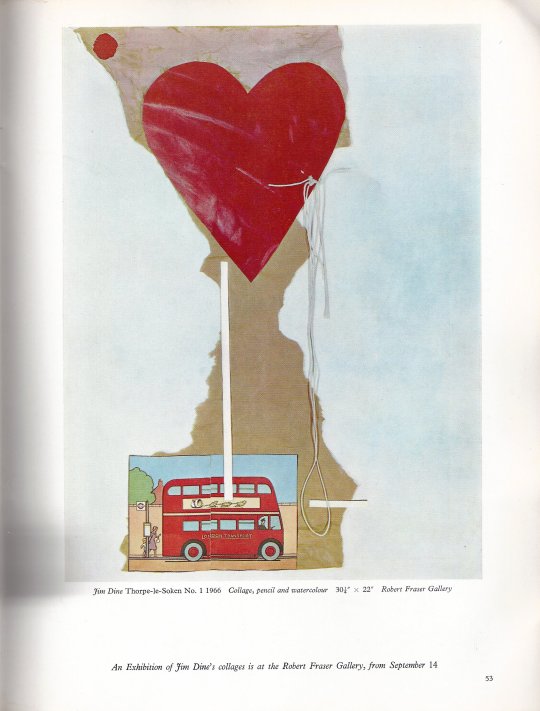
RF: But you don’t think that by the very fact of art being popular now, it brings it into a different level of communication?
JD: Oh, it does. It’s a bit more close to show business.
RF: Here I feel there’s still a very strong concept of an academic kind of an artist.
JD: Yes, and that’s a hang-up.
RF: I think traditional art, like period style, is most acceptable to the English as something which is complex and indefinable.
JD: It’s interesting too, because with all this sort of personal freedom they really don’t want to see your fly open. Whereas in American there’s not any of this personal freedom, but that’s the only way you can deal with it – with your fly open.
RF: So people really want to be comfortable about art.
JD: Titillated! It’s more like titillation. No orgasms. I like to put down information and facts very straight sometimes. I went and bought these beautiful handmade papers and I couldn’t use them, because what does it mean when you use them? You use them with a big brush and you make façades and Georgian buildings. To cut through all that I had to make these aggressive images.
RF: These drawings aren’t pornographic. They’re more anti-social?
JD: Exactly. I’ve nothing to do with pornography. They’re not sexual at all. I would say they’re rather asexual.
RF: But in this more recent series of collages, you seem to have integrated yourself into the English scene in that you’re using elements without any satirical intent.
JD: In each one I used a drawing, a little painting that Eduardo Paolozzi gave to me. I’d spent this nice day with Paolozzi and I wanted to sort of like talk about the sweetness down there at Thorpe-le-Soken.
RF: Someone can have very private reactions to things and feel the more intensive.
JD: If you have a private reaction in America, in the broad sense, you’re thought of as a spy or something. There’s no private life there. Here it’s all private. Since I’m an American I feel that I can work within the open much easier, but this situation is certainly more desirable from a personal point of view.
RF: Do you think that when you go back to the States, there will be certain changes?
JD: I have things planned that I want to do in America which I’ve planned before and they still seem right now. What I’m doing here seems just right for here. I’m interested in the fact that you, as my dealer, and I can have a discourse like this which we could not have in America, because one’s dealer in America …
RF: Has a specific realm?
JD: Yes. He isn’t someone you see in the evening. If he is then you think there’s something wrong with him.
RF: It has to be very …
JD: Tough …
RF: Interpersonal relationship.
JD: And here, if it was that, it wouldn’t interesting at all. It wouldn’t have any point.
RF: That’s due to the kind of tempo of English life. I think it’s much friendlier.
JD: Also I’ve never had a dealer who’s of my generation, which makes a difference.
RF: I feel that there’s a much tighter sort of atmosphere in New York than there was three or four years ago when I used to live there. I mean, now all the interest and activity seem to be much more concentrated on fewer artists, fewer art galleries, fewer art critics, fewer art collectors. One of the things I like about here, is that there’s a younger generation. It’s a sort of Beatle generation that has a kind of natural attitude to Dada.
JD: What do you mean by Dada?
RF: The atmosphere.
JD: Oh, I see.
RF: It seems to be completely natural to them to express themselves in that kind of way.
JD: Yes, but in America we’ve been doing it for years.
RF: But not in an artistic way.
JD: No, but people have grown up with that idea.
RF: There seems to be a kind of difference of emotional intensity here among young people. I think that it’s really the generation under 35 who are interesting here anyway. Or that has anything to say.
JD: That’s not the case in America because the generation under 35 is getting there, but then there’s this other generation of very young kids who are very corny in their rebellion, you know ‘anti’. It seems that you all go through that before here. We’ve having the first. Suddenly a generation comes up that puts everything down and that’s not terribly productive because you spend your life putting things down.
RF: But it seems to me that the youth here has a very objective viewpoint.
JD: Yes, they do. They’re quite removed. They can stand outside of it somehow. In America it’s still very self-conscious.
RF: I think Oldenburg and so on are still kind of sensational even to some sophisticated people, whereas although the non-sophisticated works is so far behind, the actual hip people seem to be much further ahead and they’re more selective. It seems to them to be completely, totally neutral and they’ve gone through the hoop.
JD: I’ve found in my short life as an artist that there’s always these sort of rare people who get it. They’re not specific, they’re not people of any particular nature but they’re always those sort who get what I’m doing or care about what I’m doing, but they certainly aren’t a group.
RF: I remember reading something that you said some time ago that in relation, particularly to your early paintings about liking the “Furlined teacup’ and that you never thought it was in any way a freak production. It was a natural thing.
JD: When I came upon that thing in the museum as an art student I wasn’t shocked you see. It only reaffirmed something, an idea what one had of, well yes, right, why not?
RF: It seems there’s a hope for a new way.
JD: I hope so. There’s got to be. We’re really hopeful, in the net 30 years of seeing a revolution in the scene, en masse. Suddenly now it’s available through communication. Look at the generation of kids who grow up with solid T.V. all the time. It’s another way of seeing. It’s not rare. It’s not even classifiable as a Surrealist thing, nor as a far out thing. It’s just part of life.
RF: So that famous gap between art and life just won’t exist any more?
JD: It doesn’t exist for me anyway. I never felt that. People always ask if you’re one of those people who bridge that gap. Well, what gap? I mean there’s art and there’s life. What does it mean?
RF: But you don’t feel that a certain school of artists in the States now seem to get around that by denying the fact of composition. That would be their way of denying the existence of art.
JD: What do you mean?
RF: Well, people like Robert Morris.
JD: Oh, I see.
RF: It’s always seemed to me that you’re particularly interested in composition.
JD: Yes, in a musical way. I really feel like a composer. Many times I feel suites of drawings are like string quartets and I think there’s a parallel. I mean just pure information …
RF: You’re interested in style?
JD: Exactly. I’m interested in style at all kinds of levels. Like today, I saw that soccer player George Cohen. There was a style you know.

7 notes
·
View notes
Text


The High Holy Days, 1944: Scenes from the liberation of Europe: France
Top, First Lt. Arthur H. Saffe leads Yom Kippur services at the synagogue in Verdun. (He doesn't appear to have been a chaplain, which is perfectly fine; in the end, we don't need no stinkin' chaplain! Also, I really love this photo. The women, whatever their charge may have been, are front and center!)
Below, 329th Infantry personnel at a Rosh Hashanah service held somewhere between Beaugency and Orleans.
From The Jewish Chronicle, September 29th:
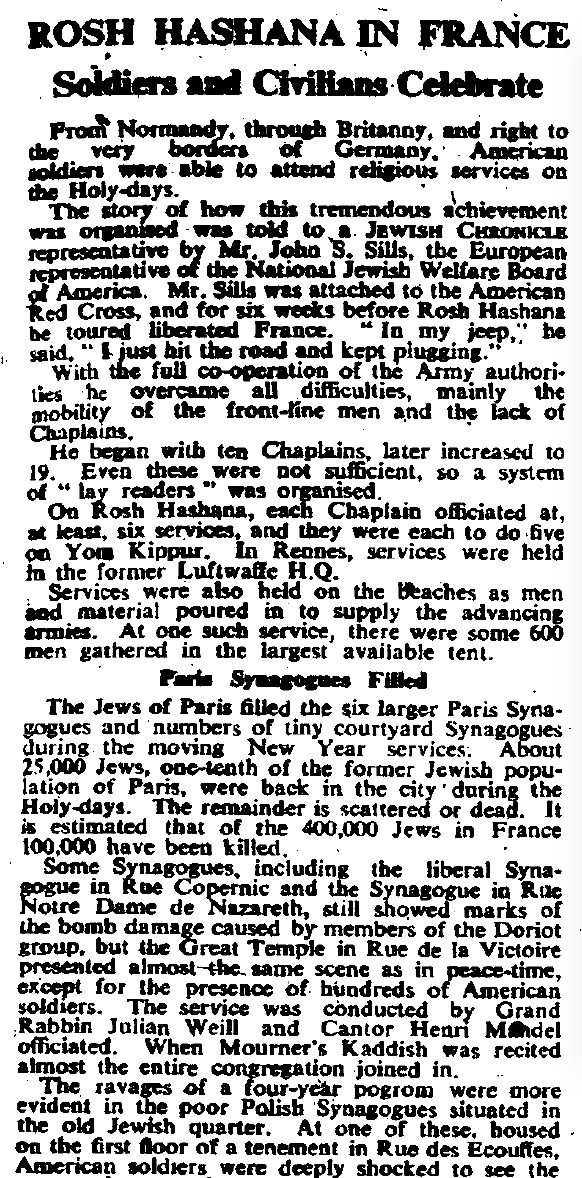

("It is estimated that of the 400,000 Jews in France 100,000 have been killed." What no one ever seems to mention is that this is a considerably higher survival rate than was the case in most occupied countries, and that this was accomplished with the help of thousands of non-Jews who took tremendous risks in order to protect their Jewish fellow citizens.)
From the biographical sketch in the finding aid to the Morris N. Kertzer Papers at the American Jewish Archives:
Rabbi Morris Kertzer was born on October 18, 1910 in Cochrane, Ontario. He received his bachelor’s degree from the University of Toronto and his master’s degree from the University of Illinois. He then studied under Mordecai Kaplan at the Jewish Theological Seminary where he earned a doctorate in Hebrew literature and he was ordained in 1934. Rabbi Kertzer would eventually separate from the Jewish Conservative movement to join the Reform rabbinate.
Kertzer served congregations in Illinois, Alabama, and Iowa before joining the army to serve as a Jewish Chaplain in World War II. During World War II Rabbi Kertzer was the only Jewish Chaplain at the Anzio beachhead, earning a bronze star for his services there. He entered Rome shortly after the liberation and spoke at the liberation ceremonies. He also served in Africa as well as Southern and Central France before returning home in 1945.
Rabbi Kertzer was active in Jewish-Christian relations, earning the International University of Rome’s Pro Deo Medal for promoting understanding between Catholics and Jews. He traveled internationally lecturing in Italy, Rumania, Japan, Turkey, India, Thailand and Israel. Rabbi Kertzer authored several books including With an “H” on my Dog Tag, his memoirs as military chaplain in World War II, What is a Jew?, (which went into more than 30 printings), Today’s American Jew, Tell me Rabbi, and The Art of Being a Jew. He also published numerous articles.
Rabbi Kertzer led the first Jewish delegation to the Soviet Union in 1956 and subsequently won the George Washington Medal for his analysis of the Soviet Union’s anti-Semitism. He served as the national president of the Jewish Military Chaplains Association, he was the national chaplain of Amvets and was the chairman of the social action commission of the Synagogue Council of America (1950’s), secretary of the New York Board of Rabbis (1957-1959), member of the executive board of the CCAR (1964-1966), and trustee of the Union of American Hebrew Congregations (1962-1967). He served as Rabbi in Larchmont, then in Riverdale, New York in the 1960’s and 1970’s. He retired in Scottsdale, Arizona where he taught at Mesa Community College, and was a member of the Jewish Federation of Greater Phoenix. He passed away on December 29, 1983.
2 notes
·
View notes
Text

Name: Lynette Erina Brown, Leandre DuPont (Formerly)
Parents: Smokey Brown and Anita DuPont
Siblings: None (?)
Birthday: November 23rd, 1940 at 5:38 P.M.
Birthplace: Bordeaux, France
Age: 18 years old (Part 2.5) 48-49 years old (Part 3)
Height: 5 ft 4 (162.56 cm)
Weight: 145 pounds (65.77 kg)
Gender: Transgender female
Pronouns: She/Her
Sexuality: Lesbian
Nationality: French (Birth to 1944), American (1944 to 1970), Japanese (1970 to 1994), French (1994 to 2011)
Race: African-American
Status: Deceased (October 28th, 2011)
Abilities: Stand
Stand: Power Of Love
Love interest: Journie Zeppeli
Medical: PTSD and General Anxiety Disorder (Diagnosed) Gender Dysphoria (Diagnosed)
Facts: She graduated from high school at 16 years old and became a licensed cosmetologist in 1956; by 1957 she was 17 years old and the assistant manager of her local salon. When she wasn't working her cosmetology job she was also working as a photographer for a small photography company. She was very successful and was earning a hefty amount of money for both of her jobs. After the events of The Forgotten Progeny, she enrolls herself in college to become a nurse. By the early 1960s she was a registered nurse. Her favourite colour is pink and her favourite food is ribollita and her favourite drink is a Shirley Temple. Her favourite musician is The Platters and her favourite actresses are Grace Kelly and Lucille Ball. Her favourite movies are The Phantom Of The Opera (1943), The Exorcist (1973), Rocky Horror Picture Show (1975), and Grease (1978). She really enjoys horror as well as romance. Her favourite books are A Clockwork Orange by Anthony Burgess and The Print Petticoat by Lucilla Andrews. Her Chinese zodiac is the Dragon. Her favourite animal is the mouse and she is afraid of fish. After Journie’s death in 1959, Lynette never decided to look for love again and was single up until the day she died.
#jjba#art#my art#jojo's bizarre adventure#jojo no kimyou na bouken#jjba oc#jjba au#the forgotten progeny#lynette brown
4 notes
·
View notes
Text
AGNÈS VARDA
LA POINTE COURTE, FROM PHOTOGRAPHS TO FILM
CLOÎTRE SAINT-TROPHIME
3 JULY - 24 SEPTEMBER 2023
09.00 AM - 07.00 PM
BILLETTERIE

Agnès Varda cherished a particular fondness for Sète. Sétoise by adoption as a teenage refugee there during World War II, she returned to the town every year until the beginning of the 1960’s. She began in 1947 as an amateur photographer, then turned professional. Her Rolleiflex captured friends, sailors, the quays of the southern town, water jousts on the canals… and soon the fisherfolk and narrow traverses of Pointe courte, the working-class neighborhood by the Étang de Thau that anchors her first film, shot in 1954.
Agnès Varda’s contact sheets reveal her photographic journey. When we compare the 800-odd photos she took in Sète with the painstaking selection the young woman undertook in 1953 to prepare her film, we begin to see her vision. These are not film stills of the shooting or the set, but images antedating the idea of the film or forming part of its conception. These reference and scouting photographs, collected on nine sheets, were her inspiration for scenes, atmospheres, even particular shots. Her favorite subjects and motifs are confirmed by their reappearance in contemporary or subsequent prints.

Alternating a graphic and a realist style, Agnès Varda produced a radical film, appreciated by cinephiles and critics of the time. Many saluted the originality of its script and especially the daring of its maker, known as the official photographer of the Festival d’Avignon and the Théâtre National Populaire. Produced on a shoestring, La Pointe Courte’s artistic independence broke with the codes of the era’s cinema to the point of being qualified as a precursor of the Nouvelle Vague.
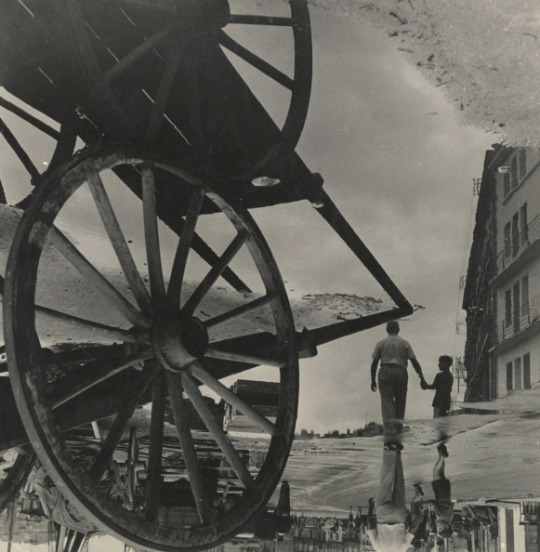
With her first photography show in June in her courtyard on the rue Daguerre (Paris 14) and the shooting that summer of her first film, 1954 crystallized for Varda the connection between these two modes of expression, announcing a unique body of work.
Carole Sandrin

CURATOR: CAROLE SANDRIN, ASSISTED BY ELISA MAGNANI.
WITH THE HELP OF ROSALIE VARDA AND THE CINÉ-TAMARIS TEAM: SHÉRINE EL SAYED TAIH, JULES MARTIN.
EXHIBITION COPRODUCED BY THE INSTITUT POUR LA PHOTOGRAPHIE DES HAUTS-DE-FRANCE AND THE RENCONTRES D’ARLES.
WITH SUPPORT FROM KERING | WOMEN IN MOTION.
2 notes
·
View notes
Photo
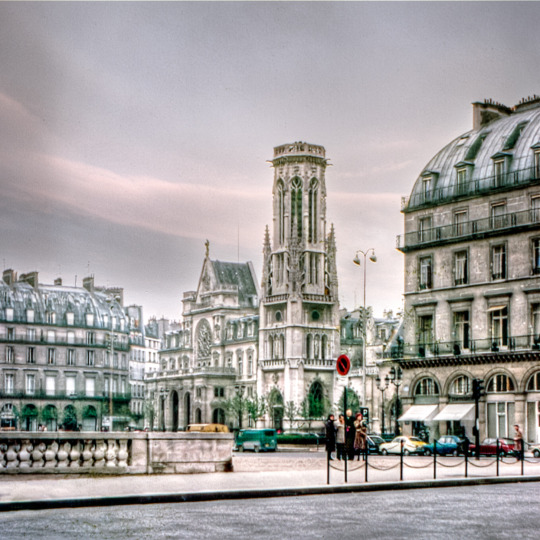
Notre Dame Cathedral, Paris, France. I took this in 1960 at age 13 when on a school exchange. I recently scanned the transparency and restored it in photoshop. Prints and other items are available from my online gallery, frankleegallery.com
#notre dame#france#paris#church#christ#christianity#Jesus#christian#catholic#roman catholic#travel#travel photography#photography#architecture
6 notes
·
View notes
Text
Cappiello’s 50 year poster: Thermogene
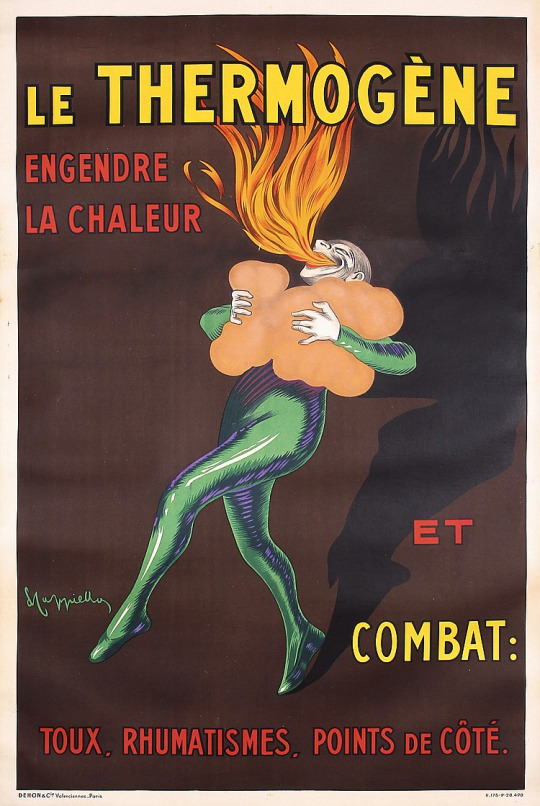
The below sources discuss the information I could find about this poster developed by Leonetto Cappiello. This poster is notable because it ran for over 50 years, only stopped when the product was discontinued. It was printed and distributed in a variety of countries, seen below in France, Italy, and Belgium. I feel that this is a measure of success in the context of advertising.
Emphasis my own.
Rare and Iconic poster by Cappiello done for Thermogene... Thermogene was a successful product sold from 1906 up until 1960's and always used Cappiello's design.
Thermogene by Leonetto Cappiello 1940 original Italian poster. (2018). Poster France. https://posterfrance.com/cappiello-leonetto/368-thermogene-cappiello-original.html
Leonetto Cappiello ( 1875-1942 ), IL THERMOGENE GENERA IL CALORE E GUARISCE…
First edition lithographic poster, 1900 ca. Cm 157x115. Probably this is the most appreciated image made by Cappiello in his long career. The Thermogène got an extraordinary success for more than fifty years; this version dates 1929 and was prepared for the Italian marketplace. QUALITY: A. Brilliant colours, excellent fresh item. Linen-backed.
Leonetto Cappiello ( 1875-1942 ), IL THERMOGENE GENERA IL CALORE E GUARISCE… - [...] | lot 12 | Affiches Vintage (Milano) at Cambi Casa d’Aste. (2022). @Auctionfr. https://www.auction.fr/_en/lot/leonetto-cappiello-1875-1942-il-thermogene-genera-il-calore-e-guarisce-hellip-15665025
Original vintage advertising poster by the renowned poster artist Leonetto Cappiello (1875-1942): Le Thermogene engendre la chaleur et combat toux, rhumatismes, points do cotes / Thermogene pads that generate heat to fight coughs and rheumatism. Iconic design featuring a figure of a man in green holding two hot pads against his chest with bright orange flames coming out of his mouth and the stylised text in French in red and yellow letters. 1930s reissue of Cappiello's classic 1909 design. Printed by Imprimerie Marci, Brussels... Country of issue: Belgium, designer: Leonetto Capiello, size (cm): 100x74, year of printing: 1930s (1909 design)
Advertising Poster Le Thermogene Leonetto Cappiello (2019) Belgium. Invaluable.com; https://www.invaluable.com/auction-lot/advertising-poster-le-thermogene-leonetto-cappiel-54-c-5554c2ab40
2 notes
·
View notes
Text
La Colonisation: French History of Death, Torture and Indescribable Violence in the Pearl of Its Evil Empire! Many Issues Arising From France’s Colonial Crimes in Algeria Have Still Not Been Resolved
— April 10, 2024 | RT
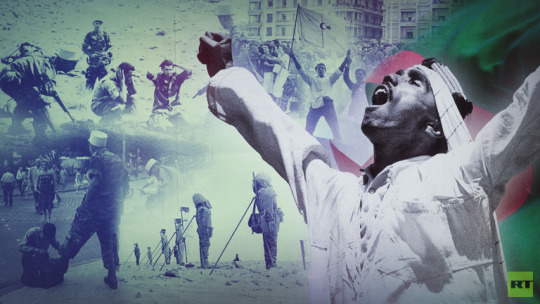
© RT/RT
Every year, Algeria remembers the colonial crimes committed by France against the Algerian people. The North African country commemorates several such dates throughout the year: February 13 – the day of the first nuclear test, July 5 – Independence Day, November 1 – Revolution Day, which marked the beginning of the eight-year independence war of 1954-1962, and December 11 – the day on which mass demonstrations started in 1960, and were brutally suppressed by French troops.
Algeria’s colonial period lasted for over 130 years, but the nation didn’t give up on its dream of breaking free from colonial oppression. Algeria’s sovereignty was finally recognized in 1962. But independence was won with a great deal of blood. According to official Algerian data, about 1.5 million local residents died in the war with France (1954-1962), about one sixth of the country’s population at the time.
Addressing the people on the occasion of Independence Day in 2021, Algerian President Abdelmadjid Tebboune recalled that the French colonialists were responsible for the most cruel violence, murder, and destruction in Algeria. Historians estimate that from 1830 to 1962 the colonialists caused the deaths of over five million people, including those who died as a result of contamination from nuclear tests.
In the 1954-1962 war against the National Liberation Front (Le Front de libération nationale, FLN), the French used civilians as hostages and human shields. Historians have documented numerous cases when French colonialists exterminated entire villages. They resorted to electric shock torture, used wells as prisons, threw prisoners from helicopters, and buried people alive in mass graves which the victims were forced to dig for themselves. The European invaders used the most sophisticated and cruel methods of torture.
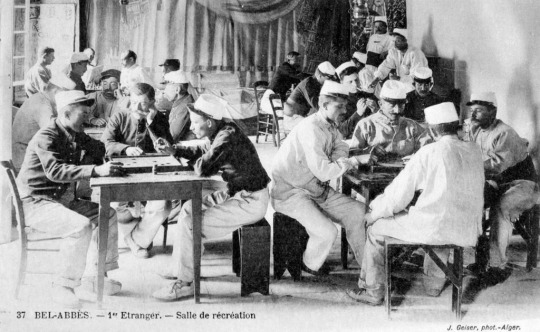
French Foreign Legion, Sidi Bel Abbes, Algeria, 20th century. French postcard. © Art Media/Print Collector/Getty Images
The Musée de l’Homme in Paris still houses 18,000 skulls acquired from dependent territories, of which only 500 have been identified, according to French media. Most of these skulls are not publicly exhibited. The skulls of several dozen Algerian resistance fighters have also been kept in the museum since the 19th century.
France’s colonial crimes affected not only people, but also Algeria’s cultural and historical heritage. During the occupation period from 1830 to 1962, the French transported hundreds of thousands of documents to Paris, including those related to the Ottoman period (1518-1830). Since gaining independence, Algeria has appealed to France to return the archive. But each time when this issue comes up, France says that according to its laws, the documents are considered classified and their disclosure is a threat to national security.
French Ontervention
The French invasion of Algeria in 1830 marked the beginning of the European country’s extensive colonization of Asian and African territories. The occupation process stretched on for several decades, as the local population put up an active resistance.
At the beginning of the 19th century, Algeria remained under the nominal rule of the Ottoman Empire, to which it regularly made tribute payments. However, the country retained much of its independence when it came to external political and commercial contacts. During France’s Italian and Egyptian campaigns (1793-1798) Algeria supplied Paris with wheat on credit. In the following decades, however, France refused to pay the debt, which resulted in major disagreements between the two countries.
In 1827, during one such dispute, Algeria’s Ottoman governor, Hussein Pasha, lost his temper and slapped the French ambassador Pierre Deval with a fly swatter (or a fan, according to other accounts). The King of France, Charles X, used this incident as an excuse to invade Algeria, believing that given the internal instability France was going through, an external military campaign could help rally society around the throne.
In the summer of 1830, a 37,000-strong expeditionary force from Paris arrived near Algiers and soon entered the city. Hussein Pasha capitulated. This victory did not help Charles X, who eventually abdicated, but the French remained in Algeria for the next 132 years.
Abd al-Qadir
Having occupied several Mediterranean ports, the Europeans decided to move inland, but at that point the local Arabs and Berbers, who had previously fought against the Ottoman Empire, put up strong resistance.
The anti-French movement was led by Abd al-Qadir, the son of the leader of the Qadiriyya, a local Sufi order. In November 1832, he was proclaimed as the emir of the Arab tribes in the west of the country, and united the local population in the fight against the French occupation. Abd al-Qadir was adept at managing territories and conducting guerrilla warfare, and fought against the invaders for 15 years. He became a legendary figure, and his fame spread throughout the Muslim world and Europe.
Abd al-Qadir was very popular among Algerians, since he was considered a descendant of the Prophet Muhammad (i.e. a Sharif) and a true ruler of the faithful. However, resorting to pogroms and the mass extermination of the local population, the French deprived him of the support of many military leaders and turned the course of the war in their favor.
The Algerians paid a heavy price for the resistance – hundreds of thousands died as a result of it. From 1847 to 1852, Abd al-Qadir remained in a French prison, after which he was released and went to live in exile in Damascus, where he died in 1883.
Algérie Française: No Rights For Locals
In the following decades, Algeria was actively colonized, and the colonial territory expanded south. By 1847, there were about 110,000 European settlers in Algeria, and by 1870 this number had doubled.
In 1848, Algeria was declared a territory of France and was designated as its overseas department, with a European Governor-General in charge. The locals became subjects (but not citizens) of France. After the Ottomans were ousted from Algeria and the Abd al-Qadir movement was suppressed, the French had to deal with several other major uprisings in the 19th century, the last of which occurred in 1871-1872.
By the beginning of the 20th century, the French had conquered lands stretching from the Mediterranean Sea to the Sahara. In the 1920s, over 800,000 French settlers resided in Algeria. Three provinces – Oran, Algiers, and Constantine – became French departments. They elected representatives to the French Chamber of Deputies, but only European settlers who backed the interests of Paris could take part in these elections. Algerians did not have the right to vote.
Economic Benefits
Economically speaking, the period between 1885-1930 is considered the golden age of French Algeria (and of the entire French Maghreb region). The country’s most important ports and cities were rebuilt and modernized and the agricultural sector was actively developed. Muslims had relative autonomy and retained their religious and cultural institutions.
The demographic boom, facilitated by European achievements in the fields of health and medicine, led to a threefold increase in the population, which reached nine million by the mid-20th century. Out of these, about a million were French colonists who seized about 40% of the cultivated land, which meant the most fertile land in the country belonged to them.
In other areas of life, there was also inequality between the locals and the colonizers. Local workers were paid less, and about 75% of Algerians remained illiterate. Despite these issues, however, peace lasted in the country for many decades.
Paris derived great economic benefits from its new territories. Algeria occupied a central place among France’s eastern possessions and its location was strategically important since the most convenient routes which connected France with its colonies in West and Central Africa passed through Algeria.

In May 27, 1956 file photo, French troops seal off Algiers' notorious casbah, 400-year-old teeming Arab quarter. © AP Photo, File
The largest and bloodiest massacre committed by France in a single day occurred on May 8, 1945, when hundreds of thousands of Algerians took to the streets to celebrate the end of World War II. When people started shouting slogans demanding independence, the colonial forces opened fire on the peaceful protesters. At least 45,000 unarmed demonstrators were killed that day.
Protests broke out in France as well, and were also brutally suppressed. October 17, 1961, went down in history as the day of the “Massacre on the Seine”, or the “Paris pogrom”. On that day, about 60,000 Algerians took to the streets of Paris, demanding an end to the colonization of their country. The French authorities again used firearms against peaceful protesters, many of whom were thrown into the River Seine. The death toll amounted to 1,500, while 800 people went missing, and thousands were detained.

The working people of Paris demanding an end to the war in Algeria. 1962. Reproduction of a photo from the newspaper L'Humanite. © RIA Novosti / Sputnik
However, this did not stop the national liberation movement in Algeria. In November 1954, an alliance of several political organizations formed the National Liberation Front (le Front de Libération Nationale), which headed the armed struggle for independence. Many underground guerrilla groups also sprang up that supported the sovereignty of Algeria. At the end of 1954, they all went into attack, and this marked the beginning of the Algerian War of Independence, which lasted until March 1962.
Paris sent additional military units to Algeria to fight the rebels. An estimated 500,000 to 1.5 million local residents and over 15,000 European servicemen died as a result of the hostilities, which lasted more than seven years.
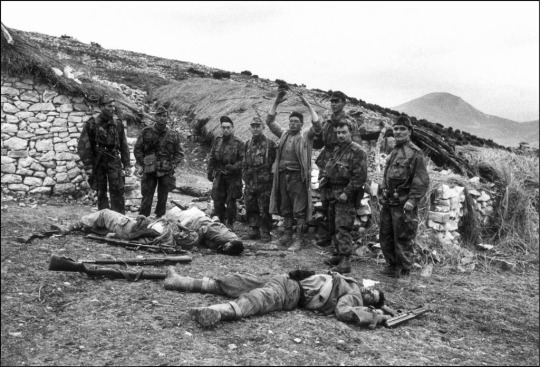
French soldiers looking at dead bodies during "Operation Bigeard" in March 1956, when an armed outbreak in Souk-Ahras, South of Constantine region, Algeria. © Reporters Associes/Gamma-Rapho via Getty Images
France won the war on a tactical level, but suffered a political and reputational defeat – its actions drew sharp criticism from its own citizens and the world community.
After negotiations and the signing of the Évian Accords, Algerians held a referendum and almost unanimously voted for independence, which was officially proclaimed on July 5, 1962.
Demining
After the war, it was necessary to clear the territory of mines. Since Algeria did not have qualified sappers, it requested assistance from European countries (Italy, Sweden, and Germany), but they refused to help. Private companies could not solve the problem either.
It was then that the USSR agreed to help Algeria, free of charge. On July 27, 1963, an agreement was signed between the Soviet leadership and Algeria. Soviet specialists removed about 1.5 million mines in Algeria from 1962 to 1965.
Nuclear Tests

A group of dummies set up on the French nuclear weapons testing range near Reggane, Algeria, before Frances third atomic bomb test, 27th December 1960. © Keystone-France/Gamma-Keystone via Getty Images
One of the greatest crimes against humanity was the testing of nuclear and chemical weapons of mass destruction, which was carried out by France from 1960 to 1966 in the Sahara Desert in Algeria.
The first nuclear explosion happened on February 13, 1960, near the town of Zaouit Reggani in southwestern Algeria and was codenamed “Gerboise Bleue”. This experiment launched the process that turned Algeria into France’s nuclear test site. The power of the nuclear bomb was estimated at 60-70 kilotons, which is about four times greater than the bomb dropped by the US on Hiroshima during WWII.
A total of 17 nuclear tests were conducted in Algeria, which led to the death of 42,000 Algerians. Many people became disabled, and the negative impact on the environment and the health of local residents is felt to this day. Algerian authorities are demanding that France hand over maps which show where the radioactive waste from these experiments was disposed of. But to this day, France hasn’t complied.
France Is Still There
France suffered a severe blow when it lost its largest African colony, from which it derived great economic benefit. To this day, many problems between the two countries have not been fully resolved, and echoes of imperialism are still evident in their relations.
Algeria wants France to officially admit its guilt, and take responsibility for the past events. However, in the past 60 years, Paris has never offered an official apology to Algeria, although some of its leaders made certain apologetic statements. Moreover, Algerian leaders often raise the issue of approving a bill which would criminalize the colonial policy of Paris.
After gaining independence, Algeria faced contradictory emotions – it wanted to put an end to its former dependence on France, but the well-established trade ties, the lack of experienced national government officials, and the military presence stipulated by the Evian Accords ensured the presence of France in Algeria. Moreover, Paris provided the necessary financial assistance and supplied Algeria with essential goods.
Things changed when Algerian authorities decided to nationalize industrial and energy enterprises in the late 1960s. France’s intervention in the Western Sahara conflict, in which it supported Morocco, and a stop in purchases of Algerian oil, which led to a trade imbalance in the late 1970s, further strained relations between the two countries. However, despite a decline in political relations, economic ties with France– especially those related to the energy sector – have remained strong throughout the history of independent Algeria.
Four Key Issues
In December 2018, Algerian Minister of War Veterans Tayeb Zitouni stated that there are four key issues (the so-called “memory file”) related to the era of imperialism: the archive of documents from the colonial and Ottoman periods, the skulls of resistance fighters which are stored in the Paris Museum, the file of people who went missing during the war of independence, and compensation for the victims of nuclear tests. Zitouni said that addressing these issues is key to ensuring normal relations between France and Algeria.
In 2020, French President Emmanuel Macron agreed to hand over the remains of 24 Algerian resistance leaders who were killed and then beheaded by French colonial troops prior to the November 1954 revolution. All of them were buried at El Alia cemetery in Algiers. Negotiations continue on the return of other skulls, the number of which is not specified.
In late 2021, new tensions sprang up between France and Algeria. In his days as a presidential candidate, Emmanuel Macron recognized the colonization of Algeria as a crime against humanity. Macron said this on February 16, 2017, during a trip to Algeria. Nevertheless, by the end of his first presidential term, the countries were on the verge of a new diplomatic crisis – Macron still had not made an official apology for the “mistakes” of the past.
On October 3, 2021, Algeria decided to “immediately recall” its ambassador to France. The reaction was a response to an interview by Macron, published in Le Monde, in which he stated that since gaining independence in 1962, Algeria has lived off “income from history” which is diligently guarded by the military and political authorities, and questioned the existence of the Algerian nation prior to French colonialism. The former colony was insulted by these words.

Monument in Kherrata. © Wikipedia
Soon, Algerian authorities took even stricter measures. The next day, Algeria banned French military planes from its airspace. This order is still in force. In 2023, the authorities declined France’s request to open Algerian airspace for French military aircraft heading to Niger, where a military coup had taken place – an event that seriously undermined France’s influence in the region.
In an attempt to improve relations with Algeria, Macron paid a visit to the country in August 2022 and signed a new partnership agreement with President Abdelmajid Tebboune, on cooperation in various fields. However, relations between the countries remain tense. Tebboune was supposed to respond with a similar visit on May 3, 2023, but it has been postponed. The reasons are the same – Algeria is still waiting for France to take action on a number of issues, which are all related to historical memory.
— By Tamara Ryzhenkova, Orientalist, Senior Lecturer at the Department of History of the Middle East, St. Petersburg State University, Expert for the Telegram Channel ‘Arab Africa’
#Feature#La Colonisation#France 🇫🇷#French History | Torture | Death | Indescribable Violence#The Evil Empire#France 🇫🇷 Colonial Crimes#Unresolved Crimes | Algeria 🇩🇿#RT#By Tamara Ryzhenkova | Orientalist | Senior Lecturer#Department of History | Middle East#St. Petersburg State University#Arab Africa#Continent of Africa | France 🇫🇷 | Nuclear ☢️ Weapons
0 notes
Text




Andy Warhol
Famous American Visual Artist and Photographer (1928 - 1987)
Warhol was not only a visual artist, but a photographer, film director, producer and leading experimentalist of the pop art movement in the 1960's
Warhol uses colour in his art pieces to convey expression and feeling
Transfers his prints onto screenprinting with use of acrylic paint - use of bright colours against a plain black or white background creates emphasis on the subject [1]
Warhols neck, shoulders and upper body has been excluded from the photo to make it appear as if his head is floating amongst a black background - draws attention to his facial features, expression and costume (wig)
Warhol pushes the boundries of self portraiture by getting 'in your face' with his photography - getting very close to the camera and having a very short depth of field to draw emphasis to his face only
The Warhol Foundation, (1986), Self Portrait, Andy Warhol, Tate, https://www.tate.org.uk/art/artworks/warhol-self-portrait-t07146
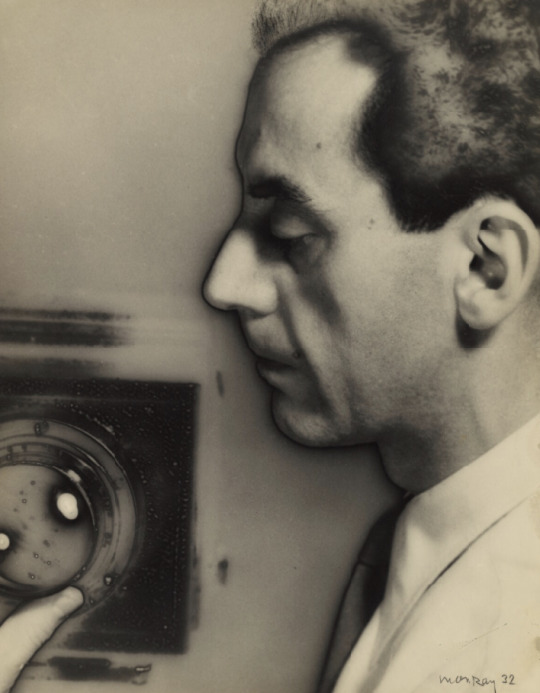



Man Ray
Famous American Photographer (1890-1976)
A visual artist and photographer who was a significant contributor to the Dada and surrealist movements. He produced many photographic works but predominantly considered himself a painter.
Man Ray is pictured adjusting the focal length on his camera as if for a tight self portrait image, however the picture is taken with the camera pointed toward the audience with him taken as part of the subject [1]
The photo is taken with quite intense light and shadow on the face and camera, almost as if purposely over-exposed
The subjects appear blurry in the image, as if to signify that they are ghostlike as the audience often forgets the human touch and effor behind the final piece of art
In this self portrait, he is not looking at the centre point of the camera, but rather at the camera itself as if he is taking a photo of something else
Man Ray Trust, (), Self Portrait with Camera 1932, Getty Museum, Man Ray Trust, https://www.getty.edu/art/collection/object/104AKV

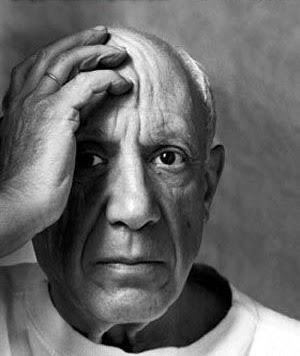


Pablo Picasso
Famous Spanish Artist (1881-1973)
A Spanish painter, sculptor, printmaker, ceramicist, and theatre designer who spent most of his adult life in France.
Picasso was mainly a painter and physical visual artist but branched out to photography and self portraits
This photo has Picasso himself featured as the subject however has the same sense of surrealism as his paintings due to his bread fingers which can only be seen if you look closely at the image
The frame around him is very busy, almost as if he was caught by surprise when taking the photo and there doesn't appear to be much preperation/staging
On his fance there is intense light and shadow, with his eyes being the most prominent part of his face lit in the photo
0 notes
Text



Edward Steichen Archive: Delphiniums Blue (and White and Pink, Too)
Edward Steichen with delphiniums (c. 1938), Umpawaug House (Redding, Connecticut). Photo by Dana Steichen. Gelatin silver print. Edward Steichen Archive, VII. The Museum of Modern Art Archives
Edward Steichen: painter, photographer, modern art promoter, museum curator, exhibition creator—and delphinium breeder.
Yes, in addition to his groundbreaking career as a visual artist and museum professional, Steichen was also a renowned horticulturist. While he lived in France, the French Horticultural Society awarded him its gold medal in 1913, and he served as president of the American Delphinium Society from 1935 to 1939. In the early 1930s, after leaving his position as chief of photography for the Condé Nast publications—including Vogue and Vanity Fair—and more than 10 years before beginning his career as Director of the Department of Photography at MoMA, he retired to his Connecticut farm to raise flowers.
Among the delphinium breeds Steichen hybridized there were “Carl Sandburg,” named for his brother-in-law and close friend (and Nobel Prize–winning poet and author), and, in the 1960s, “Connecticut Yankees”…
From left: Carl Sandburg with the "Carl Sandburg" delphinium (c. 1938), Umpawaug House (Redding, Connecticut). Photo by Edward Steichen. Gelatin silver print. Seed packet of "Delphinium Connecticut Yankees," bred by Edward Steichen (c. 1973). Offset, printed in color. Both images Edward Steichen Archive, VII. The Museum of Modern Art Archives
In June 1936, MoMA presented its first and only dedicated flower show, Edward Steichen’s Delphiniums, which exhibited—for one week only—plants Steichen had raised and then trucked to the Museum’s galleries himself. (Read the original press release for the exhibition in MoMA’s online press archives.)
Installation view of the exhibition, Edward Steichen's Delphiniums. June 24, 1936 through July 1, 1936. The Museum of Modern Art, New York. Photograph by Edward Steichen
MoMA has shown other living plants since then. Paula Hayes’s Nocturne of the Limax maximus, which includes “organically shaped vessels made from blown glass, silicone, or acrylic and filled with a rich variety of plant life,” can be seen in the MoMA lobby through April 18, 2011. Perhaps you will have a chance to see it in person; you can read about it, and hear artist Paula Hayes talk about her work, in her series of posts on Inside/Out.
I have found the items concerning Steichen, and a wealth of information about their creator, in the Edward Steichen Archive. Assembled in the Museum’s Department of Photography from 1968 to 1980 as a study resource on Steichen’s life and creative output, the archive includes original correspondence, photographs and sketches, still and moving images, tearsheets, and much more material still to be documented. In September 2010, I began a one-year project of rehousing and fully describing the archive under the auspices of MoMA’s Museum Archives. When the project is completed later this year, the collection will be fully accessible to researchers and scholars. Look for additional blog entries over the course of this year, as I discover more in the Edward Steichen Archive.
0 notes
Text

Paris Notebooks: Essays & Reviews by Mavis Gallant - 4/5
Anyone who has visited Paris, or any part of France will no doubt be familiar with la grève. The French accept labor strikes as part of daily life. It’s no doubt politically effective, though as often as you’ll hear “train’s late? C’est la grève” seldom will the matter being protested be discussed. Reading Mavis Gallant’s first-hand account of the 1968 Paris Riot while missing a boat à cause de la grève was a microdose of the social climate she immerses herself in. Unsure if she mentions the historical context ever, her thoughtfully slipshod prose instead puts the reader in a time and place where the people rioting may not have known what the protests were originally about, either. She illustrates the occasional hypocrisy of the student protesters (“We ask, ‘Why Stalin?’ She hesitates, has been asked this before, says in a parrot’s voice, ‘We are prepared to admit his errors, but he was a revolutionary, too.’ Then so was Hitler.”) but for the most part remains a sympathetic, if detached observer to the myriad of grievances. The prose is sparse (it was intended as field notes) but still remarkably funny. The Events in May: A Paris Notebook is notable for having inspired a section of the film The French Dispatch, and I had read the first half in the Anderson-edited collection An Editor’s Burial. In its entirety it remained out of print until earlier this year, and while The Events in May is clearly the centerpiece of this collection, the other essays are worth mentioning.
The second longest piece in this book is a true-crime essay of almost 70 pages called “Immortal Gatito: The Gabrielle Russier Case,” which was also a surprisingly enthralling read. It tells the story of a female schoolteacher who slept with a 16 year old student, and the ensuing legal battle and eventual suicide of Gabrielle Russier. To make the case understandable for American audiences (the account was originally published in the New Yorker) Gallant expounds on the nuances of Napoleonic law, and somehow makes that interesting. For example, “in a French murder trial the jury is not asked to decide if the defendant did it but if he is guilty,” a nuance which creates nuances such as a man who stabbed his neighbor to death simply for being annoying (“the court expressed sympathy for persons who live in noisy and jerry-built apartment houses.”) But interestingly, this leniency is what caused the courts to come down so hard on Russier (a divorcée). Doubtlessly statutory rape is never okay, but in 1960s France, the same crime committed by a man against a girl would be treated with leniency; this double standard is what sparked a lot of the culture war surrounding this case. “Immortal Gatito” is not an essay I would have sought out if it had not been in this volume, but Gallant treats her subjects with both nuance and sympathy without necessarily forgiving their actions and it made for a fascinating read.
The rest of this collection was not as interesting as these two pieces, and it seemed a lot of them were chosen at random simply for being about Paris, almost as if to cram the book to justify the price. There are some introductions Gallant wrote to various biographies such as Paul Léautaud and Marguerite Yourcenar, but nothing as personal in voice as A Paris Notebook. Her voice throughout makes me want to read more, but I didn’t get enough of an impression from these alone. The last section of the book is reviews of other books, none of which I had read, and mostly biographies. Reading them felt Borges-level meta; though I didn’t get anything out of them, here I am writing a review of reviews.
#Mavis Gallant#Paris Notebooks: Essays & Reviews#The Events in May: A Paris Notebook#journalism#nonfiction#autobiography#biography#4#december 2023#2023
0 notes
Text
LEON TROTSKY
LEON TROTSKY
1879-1940
Russian Revolutionary, Communist, Assassinated
Leon Trotsky was born in Yanovka, Ukraine to Jewish parents and was a follower of Karl Marx. He was a communist and was exiled in Siberia but escaped to London three years later, met Vladimir Lenin and worked as a revolutionary journalist. He joined the Bolshevik revolution in Russia and created the Red Army, Trotsky was one of the architects of the Russian Revolution in 1917. Lenin died in 1924, and Stalin and Trotsky struggled for power.
When Stalin was elected general secretary in 1922, Lenin warned the party of Stalin’s ambition. Stalin denounced Trotsky and kicked him out of the party and forced him into exile in Central Asia. Trotsky fled overseas in 1929 but continued to criticise Stalin in print. Stalin wanted Trotsky silenced and had his family and supporters killed. Trotsky tried to find a country he could settle down in with his wife, Natalie and during this time they lived in France and Mexico. Stalin put Trotsky on a ‘show trial’ in his absence in 1937 and Trotsky was sentenced to death, and Stalins secret police were sent to assassinate him.
Trotsky, his wife and son were living in a small village, Coyoacan when a Soviet agent raided his home in 1940, Trotsky and his family hid under a bed, a bomb which was left behind failed to go off which saved their life.
Secret Soviet Agent, Ramon Mercader (codename ‘gnome’) pretended to be a French-Canadian supporter of Trotsky to gain access to him. On 20 August 1940, he visited Trotsky to ‘discuss an article he had written’. Mercader had an ice-pick hidden in his raincoat, and when Trotsky was sitting in his chair reading the article, Mercader stabbed him in the head with it. Trotsky didn’t immediately die, his wife in the next room heard him and Trotsky and Mercader struggled until his bodyguards arrived. The bodyguards almost beat Mercader to death and was then handed over to Mexican authorities. Trotsky was operated on but died the next day aged 60.
Mercader refused to reveal his identity or who ordered Trotskys assassination (he was believed to have been one of Stalin’s agents). Mercader was sentenced to 20-years imprisonment, and his identity was revealed in 1953 and more information was came to light after the dissolution of the Soviet Union in 1991. He was released in 1960 and moved to Cuba where the Castro regime welcomed him as a hero, and he died in Havana in 1978, aged 65.
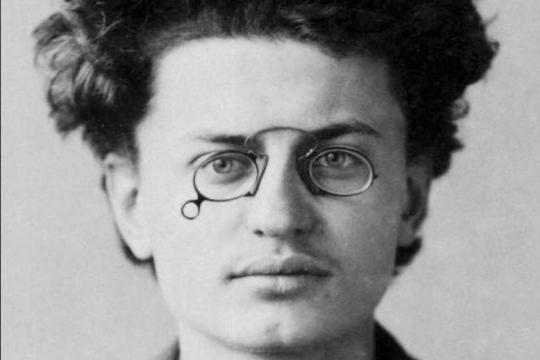
#leontrotsky #russianrevolution #communism
1 note
·
View note